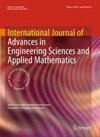Eco-friendly management of the flea beetle, Podagrica species (Coleoptera: Chrysomelidae) on okra (Abelmoschus esculentus (L.) Moench) with Artemisia annua L. seed extract
IF 0.8
Q3 ENGINEERING, MULTIDISCIPLINARY
International Journal of Advances in Engineering Sciences and Applied Mathematics
Pub Date : 2023-03-01
DOI:10.11591/ijaas.v12.i1.pp66-73
引用次数: 0
Abstract
Okra, grown and consumed in every ecological zone, is amongst the most sort after fruit vegetable crops in Nigeria. The crop is often infested by diverse field insect pests, especially the flea beetle Podagrica species, which impinges on its growth and productivity. The application of synthetic pesticides has been the generic insect pest control measure due to its touted effectiveness. These synthetics, however, has safety concerns which include; hazard to human health, amplification of toxins in the food chain, pest resurgence, domestic animals and human poisoning, environmental pollution, insect resistance, natural enemies destruction; springs, wells, rivers, and underground water contamination. Stakeholders are advocating an alternative management approach that is sustainable with less negative social and environmental impact. This study, therefore, compared the insecticidal efficacy of Artemisia annua (source of the antimalarial artemisinin) seed extract in comparison with Cypermethrin 10 EC, a synthetic insecticide, in controlling Podagrica species, the major field insect pests of okra. The trial was set out in a 7 x 4 factorial arrangement integrated into a randomized complete block design and replicated thrice. Cypermethrin 10 E.C was tested at 0.25 ml, 0.50 ml, and 0.70 ml/100 ml of water, while Artemisia annua extract was applied at 1.00 ml, 2.00 ml, and 3.00 ml/100 ml of water respectively. The control for both treatments was designated 0.0 ml. Data on leaf damage and flea beetle abundance were carried out from 4-10 weeks after planting (WAP) whilst the pods’ weight was measured at maturity. The result shows that i) the concentrations of Artemisia extract and Cypermethrin sprayed provided comparable protection to okra against the flea beetle; ii) the yield of okra (pod weight) does not vary between Artemisia annua extract and Cypermethrin treated plots; and iii) flea beetle infestations vary with okra developmental stages.秋葵(Abelmoschus esculentus, L.)上蚤甲(鞘翅目:金蝇科)的生态管理黄花蒿(Artemisia annua L.)种子提取物
秋葵在每个生态区都有种植和消费,是尼日利亚仅次于水果蔬菜的最常见作物之一。这种作物经常受到各种田间害虫的侵袭,尤其是蚤甲虫,影响了它的生长和生产力。合成农药的应用由于其被吹捧的有效性而成为普遍的害虫防治措施。然而,这些合成物存在安全问题,包括;危害人体健康,食物链毒素放大,有害生物卷土重来,家畜和人类中毒,环境污染,昆虫抗性,天敌破坏;泉水、水井、河流和地下水污染。利益相关者正在倡导一种可替代的管理方法,这种方法是可持续的,对社会和环境的负面影响较小。因此,本研究比较了青蒿(抗疟青蒿素的来源)种子提取物与合成杀虫剂氯氰菊酯10 EC对秋葵主要田间害虫——脚甲虫的杀虫效果。试验采用7 × 4的因子排列,纳入随机完全区组设计,重复3次。氯氰菊酯10 E.C分别以0.25 ml、0.50 ml和0.70 ml/100 ml水和青蒿提取物分别以1.00 ml、2.00 ml和3.00 ml/100 ml水施用。两种处理的对照均为0.0 ml。在种植后4-10周(WAP)进行叶片损害和跳蚤甲虫丰度的数据,同时在成熟时测量豆荚的重量。结果表明:(1)施用青蒿提取物和氯氰菊酯对秋葵的防蚤效果相当;ii)黄花蒿提取物和氯氰菊酯处理地块的秋葵产量(荚果重)无显著差异;(3)秋葵不同发育阶段的蚤虫数量不同。
本文章由计算机程序翻译,如有差异,请以英文原文为准。
求助全文
约1分钟内获得全文
求助全文
来源期刊

International Journal of Advances in Engineering Sciences and Applied Mathematics
ENGINEERING, MULTIDISCIPLINARY-
自引率
0.00%
发文量
6
期刊介绍:
International Journal of Advances in Engineering Sciences and Applied Mathematics will be a thematic journal, where each issue will be dedicated to a specific area of engineering and applied mathematics. The journal will accept original articles and will also publish review article that summarize the state of the art and provide a perspective on areas of current research interest.Articles that contain purely theoretical results are discouraged.
 求助内容:
求助内容: 应助结果提醒方式:
应助结果提醒方式:


